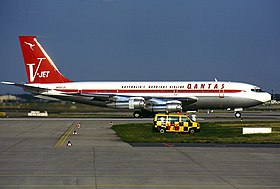Canadian Pacific Airlines Flight 322
| Canadian Pacific Airlines Flight 322 | |
|---|---|
|
An identical aircraft |
|
| Accident summary | |
| Accident type | Loss of control on landing, getting off the runway |
| place |
Vancouver International Airport , Canada |
| date | 7th February 1968 |
| Fatalities | 1 |
| Survivors | 60 |
| Injured | 17th |
| Fatalities on the ground | 1 |
| Aircraft | |
| Aircraft type |
|
| operator |
|
| Mark |
|
| Surname | Empress of Sydney |
| Departure airport |
Honolulu Airport , Hawaii , United States |
| Destination airport |
Vancouver International Airport , Canada |
| Passengers | 52 |
| crew | 9 |
| Lists of aviation accidents | |
Canadian Pacific Airlines flight 322 ( flight number : CP322) was an international scheduled flight of the Canadian airline Canadian Pacific Airlines , on which a Boeing 707-138B crashed on February 7, 1968 while landing in fog at Vancouver International Airport , with two People perished.
plane
The Boeing 707-138B ( license plate : N791SAS, serial number : 17698, Serial Number : 44) had Canadian Pacific Airlines of the US standard Airways in wetlease rented. It was delivered to its first owner Qantas on July 7, 1959 and went to Standard Airways on April 1, 1967. This first leased the machine from May 1967 to West German Südflug and from October 15, 1967 to Canadian Pacific Airlines, where it was given the name Empress of Sydney . The four-engine long-range - narrow-body aircraft was equipped with four engines of the type Pratt & Whitney Jt3d equipped. Canadian Pacific Airlines regularly used its own Douglas DC-8 aircraft on its long-haul flights.
crew
Since the aircraft was rented in wet lease, Standard Airways provided the cockpit crew consisting of two pilots, a flight engineer and a navigator. The five flight attendants on board were employees of Canadian Pacific Airlines.
the accident
The flight from Honolulu was uneventful until the approach to Vancouver . Although there was thick fog and strong winds at Vancouver Airport with visibility of 200 meters, the approach was continued. During the interception and immediately before touchdown, the pilots no longer had any visual references from which to determine their position.
At 6:20 a.m. local time, the aircraft landed hard 300 meters behind the landing threshold of runway 08 and offset to the right to the center line. It bounced off the track and rose again into the air. The master wanted to make a missed approach when the aircraft touched down a second time and there was a loss of control. The right main landing gear tires burst, causing the machine to swerve to the right. The machine collided with several small aircraft, three of which were completely destroyed. Then she tore down a maintenance shed. A worker who was in the shed was fatally injured. The machine rolled past the Air Canada terminal and brushed against a Douglas DC-8 that was being prepared for departure. One of the 707 external engines was torn down. The machine finally broke through a chain link fence and rolled head-on into an administration building, with the aircraft pushing itself into the building up to the wings.
Victim
In the accident, a technician was killed in a shed at the airport, and a flight attendant died.
Reactions
Regarding the consequences of the accident, the chairman of the Canadian transport authority said: "We were very lucky. It could have been much worse." At the same time, he expressed his regret over the two deaths caused by the accident.
Airport employees expressed their relief that the accident did not occur two hours later because significantly more ground staff would have been on shift.
causes
It turned out that both pilots had been on duty for 21 hours at the time of the accident, which significantly affected their reaction times. The machine was incorrectly configured for landing. The landing speed was too high, the rate of descent too slow. Because of the limited visibility, the approach should not have been carried out.
consequences
The machine, the value of which about 5 million before the accident $ was, was taken out of service. The airline's logos were painted over and the aircraft was towed to a remote area of Vancouver Airport, where it was stored for a few more months. The machine was then taken by boat to the Boeing plant in Everett, Washington , where it was cannibalized.
swell
- Accident report B-707-100B N791SA , Aviation Safety Network (English), accessed on April 3, 2020.
- Newspaper article about the accident
- Accident report in the Bureau of Aircraft Accident Archives
Individual evidence
- ↑ Operating History B-707-138B, N791SA Jetphotos.com, accessed March 10, 2019.
Coordinates: 49 ° 11 '38.7 " N , 123 ° 11' 3.6" W.
